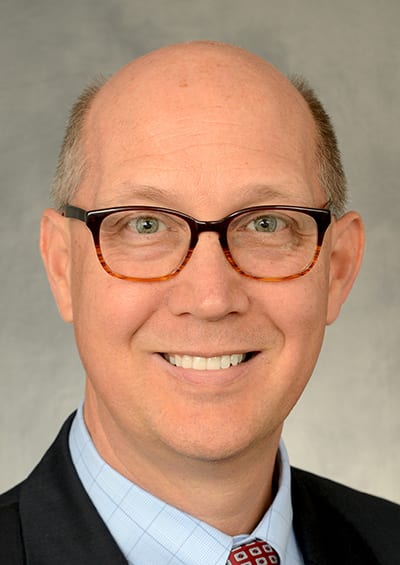
[Editor’s Note: This article is part of a series that features interviews with senior PR pros who have begun a new position recently. This month’s interview is with T. Garland Stansell, who became PRSA’s chair Jan. 1. A 30-year communications veteran, Stansell is CCO of Children’s of Alabama, the pediatric health system in Birmingham. He’s had a series of leadership positions with PRSA, including treasurer (2018), secretary (2017) and at-large member of the board of directors (2015-16).
His priorities as PRSA chair include broadening training for the group’s 30,000 members so they are able to move easily between PR, marketing, advertising and social media.
During the interview he also emphasized the importance of practicing PR with an ethical underpinning. In addition, he advocates that those considering a graduate degree in PR think about pursuing an MBA instead. The business degree, he believes, will better equip PR pros to go beyond ‘a seat at the table’ and propel them to credibility within the boardroom. As it’s Black History Month, we also asked about diversity and inclusion. His edited responses follow.]
PRNEWS: What issues are top of mind for PRSA’s members, and how are you addressing them?

Chair, PRSA
CCO,
Children’s of Alabama
T. Garland Stansell: There are a few things. One is the convergence of disciplines. Part of PRSA’s strategic plan, which we just launched [for 2020-2222], looks at the convergence of disciplines.
We are no longer looking at PR in its own bubble. Communications professionals now find themselves doing more than traditional public relations, but also extended public relations, which includes marketing, advertising and all facets of communications.
What we are hearing from members is that this convergence sometimes creates challenges in the workplace. Certainly, some of our members are not prepared for convergence, since they’ve never operated in some of these other disciplines.
Along those lines, we’re also looking at how we might better prepare students, our PRSSA members, to not operate in a public relations bubble, but instead to get outside of that silo and to understand more about marketing and advertising and all communications facets.
Technology and the 24-Second News Cycle
The other issue we hear about concerns the rapid proliferation of technology. Because of technology, we now have social media and a more global perspective. At one time the news cycle was 24 hours. Now it may be 24 minutes or, in some cases, 24 seconds.
That leads to the need to respond quickly [to media]. In some cases, tech is changing the way communications professionals do their jobs. You see AI coming. What does that mean for the way we’ll be communicating in the future?
Those are two of the biggest challenges. There are a few others, such as doing more with less. Similar to shrinking newsrooms in the media landscape, there also is shrinking staffing in corporations and agencies. Or, at least, if they’re not shrinking, they’re not adding staff, and they’re expected to do more with less.
PRNEWS: We spoke with a group of students and grad students at a recent PRSA event and were shocked to find out that they had little knowledge of communications measurement. None of them knew of the Barcelona Principles, and they were unsure of a measurement requirement on their curriculum. Does that surprise you?
Stansell: Measurement continues to be a challenge. On a professional level, we are finding measurement and the need to show ROI continues to grow, particularly if we are going to effect change within our organizations.
From the perspective of the agencies, we have to do a better job of measurement and showing progress.
It is shocking that at the university-level students are not looking at measurement. We’re hoping that through our work this year with PRSA professional advisors and academic advisors, and through the universities where we have PRSSA chapters, we can at least start a dialogue. Our goal is some movement toward [ensuring] students [are] better prepared.
We find the students are pretty good at technologies because of the world they live in. But how they use those technologies in communications is lagging behind.
PRNEWS: You spoke earlier of the news cycle and how sometimes it’s 24 seconds. Do crisis communicators need to respond that quickly?
Stansell: There’s an expectation from the media, and the public, that a spokesperson or a company has to respond quickly. If we, as communicators, can respond quickly in a way that is truthful and ethical and provide useful information, then we should. But that’s not always possible.
We live in a media-gratification world, but it’s OK to say, “I can’t speak to that or provide information at this point. I will get back to you as quickly as I can.”
The important thing is to be sure you’re providing facts and that they’re truthful and credible, with honesty and an ethical underpinning.
Ethics and Response Time
Where the challenge comes, especially for electronic media, people want to be first with the story…if we don’t give [media] an answer sometimes they go to an eyewitness or some other person or organization to provide an answer that may not be credible or correct. And then you find yourself having to manage misinformation. That’s the risk you take.
It’s imperative that any messaging we’re sharing with media, employees and the community is based in ethics and fact. In the long run, that’s the best approach.
PRNEWS: How does PR regain credibility? The age-old question: How does PR get a seat at the proverbial table? Is it by having a solid understanding of how business works?
Stansell: Yes. I would say for students, if they have the opportunity to have a business minor when they’re getting their communications degrees, it would really be great.
If they’re going to graduate school after getting a communications undergraduate degree, instead of getting a masters in communications, it would be good to get an MBA. They’ll be better able to position themselves in the market, with a firmer understanding of communications decisions.
Businesses are more and more discovering that communications is a strategic imperative. So senior communications managers need [to have] a good business understanding.
We’re finding that it’s not enough to have a seat at the table corporately, but a seat at the table at the board level. [Having a strong understanding of business] can make a real difference for the communications person operating at that level. They’re not able to operate at that level if they don’t have a proper understanding of how business operates.
PRNEWS: If you could get every PRSA member in a room and give them a message about 2020, what would you say?
Stansell: Have the courage to change and to lead change Sometimes organizations and individuals are afraid to change. But change is happening all around us. So, change can happen to us, or we can help effect the change and guide it in a productive direction.
The other thing, and it’s another of our strategic priorities, is to look at diversity and inclusion, which also takes courage. Diversity exists. We’re in a diverse world. But it’s really up to us as communicators to decide what we do about diversity. The really important piece is inclusion and how we promote inclusion among diverse people and ideas.
Part of that involves civility and how we, as communicators, promote civil discourse. People are moving away from the ability to discuss differences of opinion in a productive, civil manner. As communicators, we can help promote civil discourse about how to include all opinions, which are not inherently bad; they’re just different.
CONTACT: rod.granger@prsa.org
